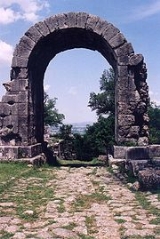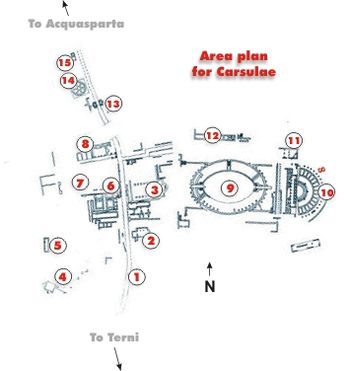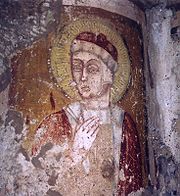
Carsulae
Encyclopedia

Umbria
Umbria is a region of modern central Italy. It is one of the smallest Italian regions and the only peninsular region that is landlocked.Its capital is Perugia.Assisi and Norcia are historical towns associated with St. Francis of Assisi, and St...
, central Italy
Italy
Italy , officially the Italian Republic languages]] under the European Charter for Regional or Minority Languages. In each of these, Italy's official name is as follows:;;;;;;;;), is a unitary parliamentary republic in South-Central Europe. To the north it borders France, Switzerland, Austria and...
, now one of the most important archaeological ruins in Italy. It is located c. 4 km north of San Gemini
San Gemini
San Gemini is a comune of c. 4,500 inhabitants in the province of Terni in the Italian region Umbria, located about 60 km south of Perugia and about 10 km northwest of Terni....
, a small comune
Comune
In Italy, the comune is the basic administrative division, and may be properly approximated in casual speech by the English word township or municipality.-Importance and function:...
in the province of Terni
Province of Terni
The Province of Terni is the smaller of the two provinces in the Umbria region of Italy, comprising one-third of both the area and population of the region. Its capital is the city of Terni...
. Nearby is the comune of Montecastrilli
Montecastrilli
Montecastrilli is a comune in the Province of Terni in the Italian region of Umbria, located about 50 km south of Perugia and about 15 km northwest of Terni.-External links:*...
(Montes Carsulis).
Origins and history
Most historians fix the town's official founding to about 300 BC. Carsulae's growth into a major town only took place, however, with the building of the ancient Roman road, the via FlaminiaVia Flaminia
The Via Flaminia was an ancient Roman road leading from Rome over the Apennine Mountains to Ariminum on the coast of the Adriatic Sea, and due to the ruggedness of the mountains was the major option the Romans had for travel between Etruria, Latium and Campania and the Po Valley...
, in 220-219-BC. Carsulae probably originated as a mansio
Mansio
In the Roman Empire, a mansio was an official stopping place on a Roman road, or via, maintained by the central government for the use of officials and those on official business whilst travelling.-Background:The roads which traversed the Ancient World, were later surveyed,...
, a rest stop and watering place for travelers, traders and soldiers.
When the via Flaminia was built, its western branch proceeded north from Narni
Narni
Narni is an ancient hilltown and comune of Umbria, in central Italy, with 20,100 inhabitants, according to the 2003 census. At an altitude of 240 m , it overhangs a narrow gorge of the Nera River in the province of Terni. It is very close to the Geographic center of Italy...
, sparking the development not only of Carsulae, but also of Acquasparta
Acquasparta
Acquasparta is a town and comune in the province of Terni . It is located on a hill above the Naia Valley and the river of the same name, facing the Monti Martani mountain range....
and Bevagna
Bevagna
Bevagna is a town and comune in the central part of the Italian province of Perugia, , in the flood plain of the Topino river.Bevagna is 25 km SE of Perugia, 8 km west of Foligno, 7 km north-north-west of Montefalco, 16 km south of Assisi and 15 km north-west of Trevi.It...
. This branch of the road courses through a gently rolling upland plain at the foot of the Martani mountain range, an area that had been heavily populated since the middle of the Bronze Age
Bronze Age
The Bronze Age is a period characterized by the use of copper and its alloy bronze as the chief hard materials in the manufacture of some implements and weapons. Chronologically, it stands between the Stone Age and Iron Age...
. The eastern branch proceeded from Narni to Terni
Terni
Terni is a city in southern Umbria, central Italy, capital of the province of Terni, located in the plain of the Nera river. It is 104 km N of Rome, 36 km NW of Rieti, and 29 km S of Spoleto.-History:...
, north to Spoleto
Spoleto
Spoleto is an ancient city in the Italian province of Perugia in east central Umbria on a foothill of the Apennines. It is S. of Trevi, N. of Terni, SE of Perugia; SE of Florence; and N of Rome.-History:...
, then past Trevi
Trevi
Trevi is an ancient town and comune in Umbria, Italy, on the lower flank of Monte Serano overlooking the wide plain of the Clitunno river system. It is 10 km SSE of Foligno and 20 km north of Spoleto....
and finally to Foligno
Foligno
Foligno is an ancient town of Italy in the province of Perugia in east central Umbria, on the Topino river where it leaves the Apennines and enters the wide plain of the Clitunno river system...
, where it merged with the western branch.
In due course, during the age of Emperor Augustus, Carsulae became a Roman municipium
Municipium
Municipium , the prototype of English municipality, was the Latin term for a town or city. Etymologically the municipium was a social contract between municipes, the "duty holders," or citizens of the town. The duties, or munera, were a communal obligation assumed by the municipes in exchange for...
. During his reign a number of major works wewre begun, eventually including the amphitheatre
Amphitheatre
An amphitheatre is an open-air venue used for entertainment and performances.There are two similar, but distinct, types of structure for which the word "amphitheatre" is used: Ancient Roman amphitheatres were large central performance spaces surrounded by ascending seating, and were commonly used...
, most of the forum, and the marble-clad Arch of Trajan (now called the Arco di San Damiano).
During its "golden age" Carsulae, supported by agricultural activity in the surrounding area, was prosperous and wealthy. Its bucolic setting, its large complex of mineralized thermal baths, theatres, temples and other public amenities, attracted wealthy and even middle class "tourists" from Rome.
However, while all the other mentioned towns and cities on the two branches of the old Roman road continue to exist, nothing but ruins remains of Carsulae, which was abandoned, and once abandoned, never resettled. The only subsequent building that took place occurred in paleo-Christian times, about the 4th or 5th century, at the southerly entrance to Carsulae, where the church of San Damiano, still standing today, was built for a small community of nuns on the foundations of an earlier Roman building.
For centuries after it was deserted, Carsulae was used as a quarry for building materials that were used elsewhere, such as in Spoleto or Cesi
Cesi
Cesi is a frazione of the Italian comune of Terni, in the province of Terni, southern Umbria, Italy. The small borgo, which retains its late-medieval aspect, set among olive groves, lies "stretched out lengthwise along a narrow contour on the slopes of M. Torre Maggiore," about 18 km north of...
, where Roman tombstones may be seen built into the church of S. Andrea, but otherwise, it was left alone. Consequently, archaeologists have been able to map the city with considerable detail.
No one knows the precise reasons why Carsulae was abandoned, but two that seem most plausible are first, that it was almost destroyed and the site made inhospitable by an earthquake
Earthquake
An earthquake is the result of a sudden release of energy in the Earth's crust that creates seismic waves. The seismicity, seismism or seismic activity of an area refers to the frequency, type and size of earthquakes experienced over a period of time...
, and second that it lost its importance and as a result became increasingly impoverished because most of the important north-south traffic used the faster east branch of the via Flaminia. J.B. Ward-Perkins suggested another effect of increasingly unsettled times from the third century, when the very trunk roads that had been economic lifelines became access roads for hordes of unpaid fighters: "Henceforth the tendency must have been to move away from the roads, until by the Middle Ages the roads themselves were as bare of settlement as they had been when they were first built."
Haphazard excavations took place in the 16th century under the direction of Duke Federico Cesi
Federico Cesi
Federico Angelo Cesi was an Italian scientist, naturalist, and founder of the Accademia dei Lincei. On his father's death in 1630, he became briefly lord of Acquasparta.- Biography :...
, whose palazzi are in Cesi Acquasparta
Acquasparta
Acquasparta is a town and comune in the province of Terni . It is located on a hill above the Naia Valley and the river of the same name, facing the Monti Martani mountain range....
, and in the 17th century under the direction of Pope Pius VI
Pope Pius VI
Pope Pius VI , born Count Giovanni Angelo Braschi, was Pope from 1775 to 1799.-Early years:Braschi was born in Cesena...
, but not until 1951 were the ruins subjected to methodical archaeological exploration and documentation. Significant additional work was also done in 1972. There is a current excavation run by Professor Jane Whitehead through Valdosta State University of Georgia focusing on the bath complex and pre-Roman polygonal wall south of the city. They are in their fifth season with plans to continue.


Monuments
- Via FlaminiaVia FlaminiaThe Via Flaminia was an ancient Roman road leading from Rome over the Apennine Mountains to Ariminum on the coast of the Adriatic Sea, and due to the ruggedness of the mountains was the major option the Romans had for travel between Etruria, Latium and Campania and the Po Valley...
. The western branch of the ancient Roman road passed through Carsulae. The via Flaminia was the "main street" of the city, and the stretch that runs through the city features sidewalks and gutters. - Chiesa di San Damiano, first built in paleo-Christian times on the remains of a Roman buildingChristianised sitesOne aspect of Christianisation was the Christianisation of sites that had been pagan. In the 1st centuries of Christianity churches were either house churches in whatever houses were offered for use by their owners, or were shrines on the burial-sites of martyrs or saints, which following the usual...
whose original purpose is unknown. Remnants of this building are still in evidence on the south side of the church. The primitive church was a rectangular space with an apse. A portico and two interior colonnades were added during the 11th century using materials gathered from the site, including items that probably decorated the Basilica or were architectural pieces from the Forum. - BasilicaBasilicaThe Latin word basilica , was originally used to describe a Roman public building, usually located in the forum of a Roman town. Public basilicas began to appear in Hellenistic cities in the 2nd century BC.The term was also applied to buildings used for religious purposes...
, the public meeting hall for the citizens of Carsulae. The interior hall, which is rectangular, has a central nave and two side aisles separated by rows of columns. The apseApseIn architecture, the apse is a semicircular recess covered with a hemispherical vault or semi-dome...
at the far end would have held a magistrate's chair, used to arbitrate or adjudicate disputes and dispense justice. - Public Baths, mineralized, thermal baths.
- Cistern, now an Antiquarium, held water for use by the people of the town.
- Temples. Two temples, sometimes called the "twin temples" were devoted to the gods of two unknown Roman divinities. Only their diases, sheathed in pink rock, remain today.
- The Forum, the main public "square" of the ancient city, built on a terraced structure in and around the Basilica and twin temples. The line of vaulted structures, or "tabernae", near the Forum might have been market stalls or shops.
- Public buildings. Used for unknown purposes, they probably housed administrative offices for the local government, or served as palaces for aristocratic families. There are four sumptuously decorated rectangular rooms with apses, with marble walls and floors incorporating both marble and opus sectilis.
- AmphitheatreAmphitheatreAn amphitheatre is an open-air venue used for entertainment and performances.There are two similar, but distinct, types of structure for which the word "amphitheatre" is used: Ancient Roman amphitheatres were large central performance spaces surrounded by ascending seating, and were commonly used...
. Sitting in a natural depression to the east of the via Flaminia, was probably built during the Flavian dynastyFlavian dynastyThe Flavian dynasty was a Roman Imperial Dynasty, which ruled the Roman Empire between 69 and 96 AD, encompassing the reigns of Vespasian , and his two sons Titus and Domitian . The Flavians rose to power during the civil war of 69, known as the Year of the Four Emperors...
. It is built primarily of layers of limestone blocks and bricks. - Theatre. It was probably built in the time of Augustus, before the building of the amphitheatre. The primary building material for the theatre was opus reticulatumOpus reticulatumOpus reticulatum is a form of brickwork used in ancient Roman architecture. It consists of diamond-shaped bricks of tuff placed around a core of opus caementicium...
. - Collegium Iuvenum, a college or school for young people.
- Cistern - Another structure built to contain water for the use of citizens.
- Arco di Traiano - Arch of San Damiano - Originally consisting of three marble- clad arches, of which only the center arch remains. It was also built during the time of Augustus as a symbolic north entrance to the city.
- Funerary monument, known as the tumulus, a much restored funerary monument of an aristocratic family, possibly the Furia family. A plaque now kept at the museum in the Palazzo Cesi in Acquasparta may have been taken from this monument.
- Funerary monument - a less distinguished monument in the necropolis of Carsulae.
Visitor Information
(As of September 2008)April - September: Open daily from 08.30 to 19.30
October - March: Open daily from 08.30 to 17.30
Closed on Christmas Day, 1 January and 1 May
Entrance fee: €4.40 (or €3.30 concessionary fee)
Facilities: Visitor centre with disabled access, cafe, and car parking.

